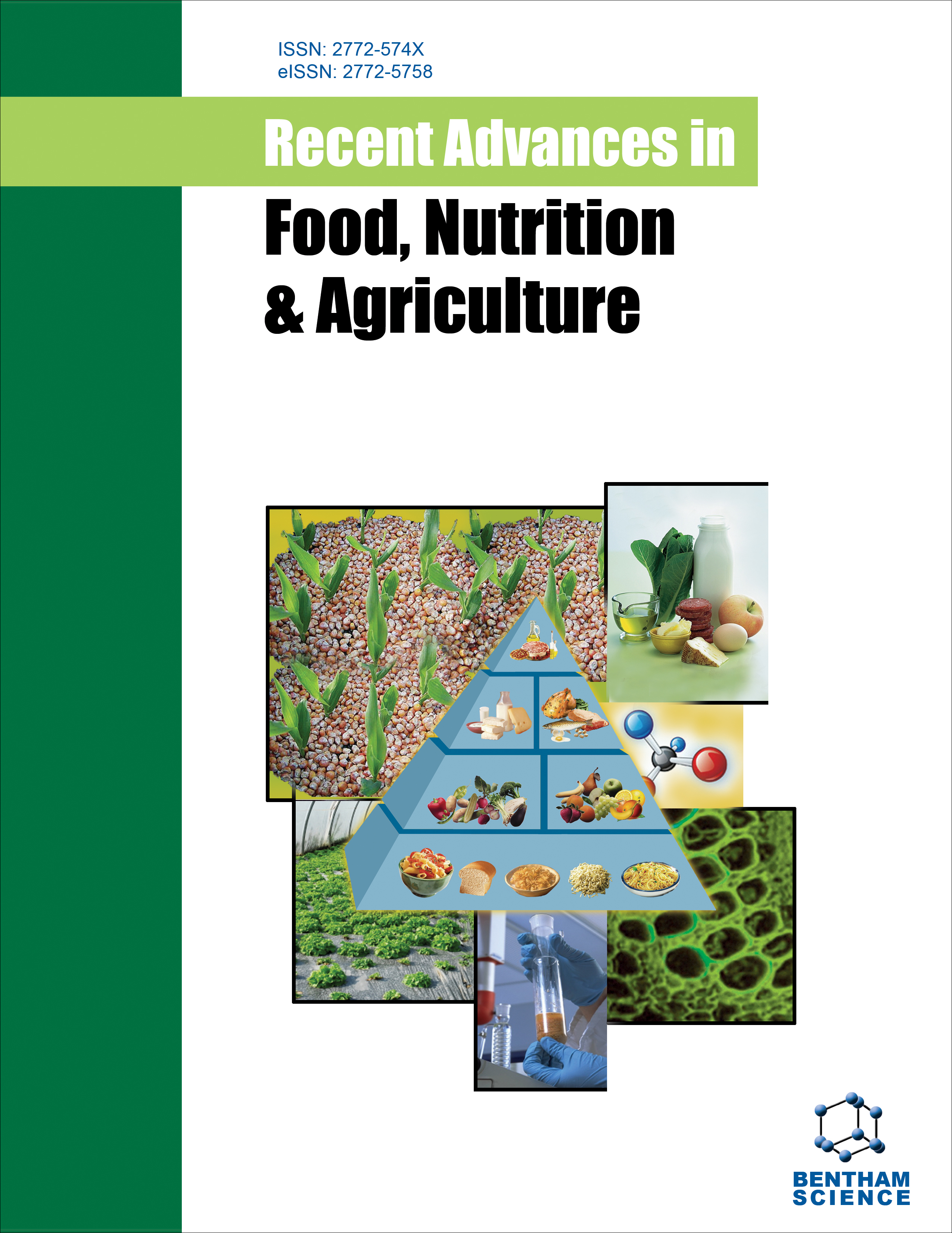Recent Advances in Food Nutrition & Agriculture - Current Issue
Volume 16, Issue 1, 2025
-
-
Cholesterol Absorption Inhibition by Some Nutraceuticals
More LessHyperlipidemia, characterized by elevated levels of lipids in the blood, represents a major risk factor for cardiovascular diseases, a leading cause of morbidity and mortality worldwide. Conventional pharmacological interventions have been effective in managing hyperlipidemia, but concerns about side effects and long-term use have prompted interest in alternative approaches, particularly the use of nutraceuticals. This comp Read More
-
-
-
Phyto-pharmacological Potential of Aegle marmelos (L.) for Neurological Disorders: Progress and Prospects
More LessAuthors: Jyotsana Dwivedi, Pankaj Kumar, Pranjal Sachan, Charan Singh, Bhagawati Saxena, Ankita Wal and Pranay WalBackgroundAegle marmelos, an Indian plant, has been extensively utilized by the people of the Indian subcontinent over about 5000 years. The leaves, bark, roots, and fruits, including seeds, are widely used to cure a variety of diseases in the Indian traditional system of medicine, Ayurveda, along with numerous folk medicines. By revealing the existence of significant bioactive chemicals, modern research has effectively subs Read More
-
-
-
Impact of High Pressure Processing on the Safety and Quality of Food Products: A Review
More LessHigh pressure processing (HPP) has become a practical food processing technique that meets the preferences of consumers seeking lightly processed, convenient, and fresh-tasting food options. This paper reviewed the latest research on the impact of HPP on the safety and quality of food products. The use of HPP has been showing favorable growth in the food industry primarily due to its potential to not only enhance Read More
-
-
-
Dandelion (Taraxacum officinale): A Promising Source of Nutritional and Therapeutic Compounds
More LessAuthors: Umi Laila, Jaspreet Kaur, Kartik Sharma, Jyoti Singh, Prasad Rasane, Sawinder Kaur and Vishesh BhadariyaBackgroundTaraxacum officinale, commonly referred to as dandelion, is a self-growing plant/ weed in various parts of India and the rest of the world (particularly the northern hemisphere). The plant’s chemical composition, including sesquiterpene lactones, saponins, flavonoids, phenols, and many other compounds, contributes positively to the human body, promoting overall health.AimThis review aims to shed light on th Read More
-
-
-
GPOSYSH: Genomic Prediction of Oryza sativa Yield and Subpopulation Using Hybrid Methods
More LessAuthors: Kiranmai Bejjam and Umang Sujeet BasuthkarAccurate prediction of breeding values is challenging due to the genotype-phenotype relationship is crucial and necessary for producing crops with elite genotypes. This paper is about investigating and predicting the phenotypic trait Height and Yeild in a genotype.BackgroundMost of the existing studies focus on genetic methods or Machine learning models, in this, we implemented a hybrid combination of genetic methods and m Read More
-
-
-
Effects of Choline Supplementation in Diets on Juvenile Pacu (Piaractus mesopotamicus): Productive Performance, Proximate Composition and Serum Lipid Level
More LessIntroductionPacu (Piaractus mesopotamicus) is a Brazilian fish species of high commercial value and has emerged as one of the main species with potential for intensive farming. This study aimed to investigate the impact of choline supplementation on productive performance, visceral fat, hepatosomatic indices, proximate composition, serum biochemical profile, and liver coloration in juvenile pacu (Piaractus mesopotamicu Read More
-
-
-
Cocos nucifera Husk Biomass as an Effective Adsorbent for Industrial Wastewater Removal: Harnessing the Power of Nature
More LessAuthors: Rishav Sharma, Rajendra Awasthi and Rishabha MalviyaBackgroundRapid industrialization has polluted waterways, threatened aquatic ecosystems and endangered human health. To solve this problem, sustainable industrial practices and innovative water treatment technology must be implemented to ensure clean and safe water for future generations.MethodsThis study aimed to investigate the adsorbent capacity of Cocos nucifera husk for ineffective removal of methylene Read More
-
-
-
Physical, Chemical and Enzymatic Changes in Amla (Emblica officinalis) Fruit during Growth and Maturation
More LessAuthors: Neelam Sachan and Vivek KumarBackgroundAmla (Emblica officinalis) is one of the most prominent fruits in terms of nutritional and medicinal properties and is utilized for the preparation of many traditional processed foods and in Ayurvedic formulations.ObjectiveThis study aims to investigate the enzyme activity and physical and chemical quality parameters during the growth and development stages of amla fruit for the determination of proper harv Read More
-
-
-
Unveiling the Compositional Analysis of Green Coffee Beans with and without Silver Skin
More LessAuthors: Shraddha Tripathi, Neha Mishra, Ritika Malaviya, Arshi Ansari, Simran Shrimali and Neetu MishraBackgroundGreen Coffee Bean (GCB) is covered with silver skin that is shed as a by-product of the roasting process. For the first time, a comparative study was conducted to differentiate the compositional analysis of green coffee beans with silver skin and without silver skin.ObjectiveThe study aims comparatively assessing nutritional, anti-nutritional and fatty acids composition of green coffee beans with Read More
-
Most Read This Month Most Read RSS feed
Article
content/journals/rafna
Journal
10
5
false
en

Most Cited Most Cited RSS feed
-
-
Drug-food Interactions in the Era of Molecular Big Data, Machine Intelligence, and Personalized Health
Authors: Romy Roy, Shamsudheen Marakkar, Munawar P. Vayalil, Alisha Shahanaz, Athira Panicker Anil, Shameer Kunnathpeedikayil, Ishaan Rawal, Kavya Shetty, Zahrah Shameer, Saraswathi Sathees, Adarsh Pooradan Prasannakumar, Oommen Kaleeckal Mathew, Lakshminarayanan Subramanian, Khader Shameer and Kamlesh K. Yadav
-
-
- More Less

